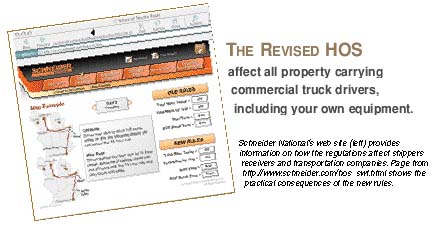Now is the time to review the efficiency of your receiving operations.
FURNITURE WORLD readers should review their scheduling and receiving operations in light of new United States Hours-of-Service (HOS) regulations. These became effective interstate nationwide and in 47 states for intrastate operations as of January 2004.
The Federal Motor Safety Administration estimates the annual cost increase of these new regulations at 3.4 billion dollars. Stated another way, the total effect of the revision is estimated to reduce driver productivity 4 to 19 percent depending on the freight characteristics of the particular load being handled. Specialized furniture carriers have long performed extraordinary services in the unloading and loading of furniture. This process termed “driver assist” significantly reduces their productivity, closer to the 19 percent figure. Ultimately your truckers’ costs are your costs. Now is the time to help your carriers limit the waiting time prior to unloading as well as speed up their actual unloading time.

Originally established in 1939, updated in 1962 and under study since 1995, the latest revisions are intended to:
•Permit commercial motor vehicle (CMV) drivers additional opportunities for quality rest and restorative sleep.
•Reduce the number of crashes caused by drowsy, tired, or fatigued CMV drivers.
The revised HOS regulations affect all property carrying commercial truck drivers, including those employed by furniture stores. The trucking industry supports the revised HOS because of expected benefits in fewer collisions and fatalities caused by driver fatigue.
In addition to following the regulations, many trucking companies equip their trucks with additional items to boost safety. For example, Cargo Transporters equipment specifications include: automatic transmissions (either the ZF Meritor Freedom or Eaton Autoshift), Vorad Collision Warning System with Smart Cruise, Lane Guidance, and Roll Stability Control safety equipment. Their specialized furniture carrier division, Cargo Consolidation Services is a major force in furniture delivery throughout their market area. For more information visit http://www.ctgrp.com/ccs/ccsindex.htm
The old HOS changes versus the new regulations are described in the chart on page 10.
The 34 -Hour Restart
Truck drivers may restart a 7/8 consecutive day period after taking 34 or more consecutive hours off-duty as long as the driver has not exceeded 60/70 hours on duty.
One might consider the one-hour reduction of total work time from 15 to 14 hours minor, but changes in the way in which drivers may compute consecutive hours on duty, make this a major revision. The 14 hours of available work time are consecutive and begin when the driver starts his tour of duty. Prior to January 4th a driver was allowed to log lunch, rest stops, and time at a shipper or consignee docks as on duty/not driving which did not count against his driving time but did apply to the total tour of duty hours. With the new changes in HOS this is no longer the case. All time from the start of tour until their 14 hours is completed is considered on duty driving except when the driver logs time (over 2 hours in length) in the sleeper which all apply to his 14 available hours.
This is one of the most costly aspects of the HOS revisions. If you are not ready to receive when a driver arrives to make a pickup or delivery at your store, the “clock” continues to run. When this occurs, utilization of carrier equipment and the driver’s time are negatively affected. Driver productivity will become a priority for our industry as we attempt to minimize the impact of the revised HOS on operating costs. Recognizing that fact, many transportation companies also have increased driver pay to maintain quality work forces and reduce drive turnover, a longstanding serious problem for the industry.
Home furnishings retailers that routinely delay the speedy completion of truckers’ duties to offset their own internal inefficiencies will see the greatest negative impact and price increases. Those companies that make their pickup and/or delivery experience more driver friendly will see the least damage to their bottom line and may actually reduce costs.
To learn more about the new HOS regulations, an excellent resource is Schneider National’s web site http://www.schneider.com/hos_swf.html. Additional Internet resources are also noted below from the Federal Motor Safety Administration.
www.fmcsa.dot.gov/Home_Files/revised_hos.as
www.fmcsa.dot.gov/hos/hos.htm
www.fmcsa.dot.gov/Home_Files/hos/brochure.pdf
www.fmcsa.dot.gov/Home_Files/hos/HOS_Presentation12.ppt
www.fmcsa.dot.gov/Home_Files/hos/cards5.pdf
Eight Best Receiving Practices
1. Concentrate routings of LTL and stop off quantities with a single carrier.
2. Receive Advance Shipping Notices (ASN) or manifests so all paperwork and labels are ready when truck arrives.
3. Minimize delays and time spent by driver for receiving or loading.
4. Use drop trailers.
5. Use yard jockeys for duties previously done by over the road drivers.
6. Improve scheduling and flexibility of delivery windows including multiple shifts.
7. Think about creative options such as an express dock for receipts with a limited number of pieces.
8. Provide a secure area for drivers to park and sleep.
Daniel Bolger of The Bolger Group helps companies achieve improved transportation, warehousing and logistics. Questions can be directed to Mr. Bolger care of FURNITURE WORLD at dbolger@furninfo.com.